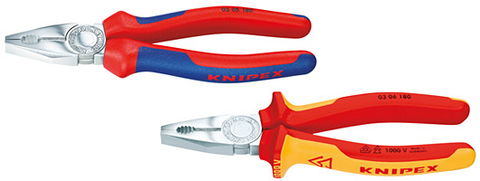Get the lowdown on KNIPEX tools: are the blue and red handle covers suitable for electricians? How can you find out what capacities can be crimped beyond the specification inscription on the pliers? Why are the cutting edges of the Electronic SuperKnips offset? Find out the answers to some commonly asked questions here.

What is the difference between the blue-red and the yellow-red handles?
The blue-red handles are two-component handles that offer the user greater comfort than, for example, a plastic coating. They also insulate against cold and heat and thus increase comfort when working under extreme conditions. The plastic used by KNIPEX also insulates against electrical current.
However, when an electrician works on electrical systems, special rules apply. For Europe, these rules are standardised in the European standard EN 50110-1. These norms apply to work on all electrical parts that work with mains current and cannot be disconnected from the mains by pulling a plug.
EN 50110-1 prescribes tools for this in accordance with the relevant standards.
EN 60900 is binding here for Europe. It determines all electrical, geometric and mechanical properties of such tools. It also prescribes how to test these properties and how to label the tools. The immersion insulation and the yellow-red insulation of the safety tools meet all of these requirements. The final check for each pair of insulated KNIPEX pliers is with 10,000 volts for dielectric strength before it is put on the market.
These requirements are not taken into account for the blue-red covers; other considerations apply to their design.
They are therefore neither approved nor tested for electricians who are supposed to work on electrical systems. If tools with blue-red sleeves without VDE approval are used on electrical systems, there is no insurance coverage from the occupational insurance associations in the event of an accident.
What capacities are given on the crimping pliers?
The capacity information on our crimping pliers often shows only one number per crimp nest due to space constraints. The inscription on the pliers indicates the largest possible cross section to be processed. However, smaller cross sections can also be processed in the same die. You can find out from the catalogue, our website and the packaging which capacities can be crimped beyond the specification.
For example, the crimping pliers KNIPEX 97 32 240 for cable lugs and cable connectors come with the information 1.5 / 2.5 / 6 mm², while it is actually suitable for sizes 0.5 - 1.5 / 2.5 / 4 - 6 mm².
Why are the cutting edges of the KNIPEX Electronic SuperKnips® offset and not directly on top of each other?
The offset of the cutting edges of the KNIPEX Electronic SuperKnips® has been deliberately chosen for the following reason:
Since the cutting edges are very sharp, they would destroy each other if they hit each other directly. That is why we have chosen a small offset of a few hundredths of a millimeter (up to a maximum of 0.2 mm) (micro cutting edge offset). This not only protects the razor-sharp cutting edges, but also reliably cuts the thinnest wire.
